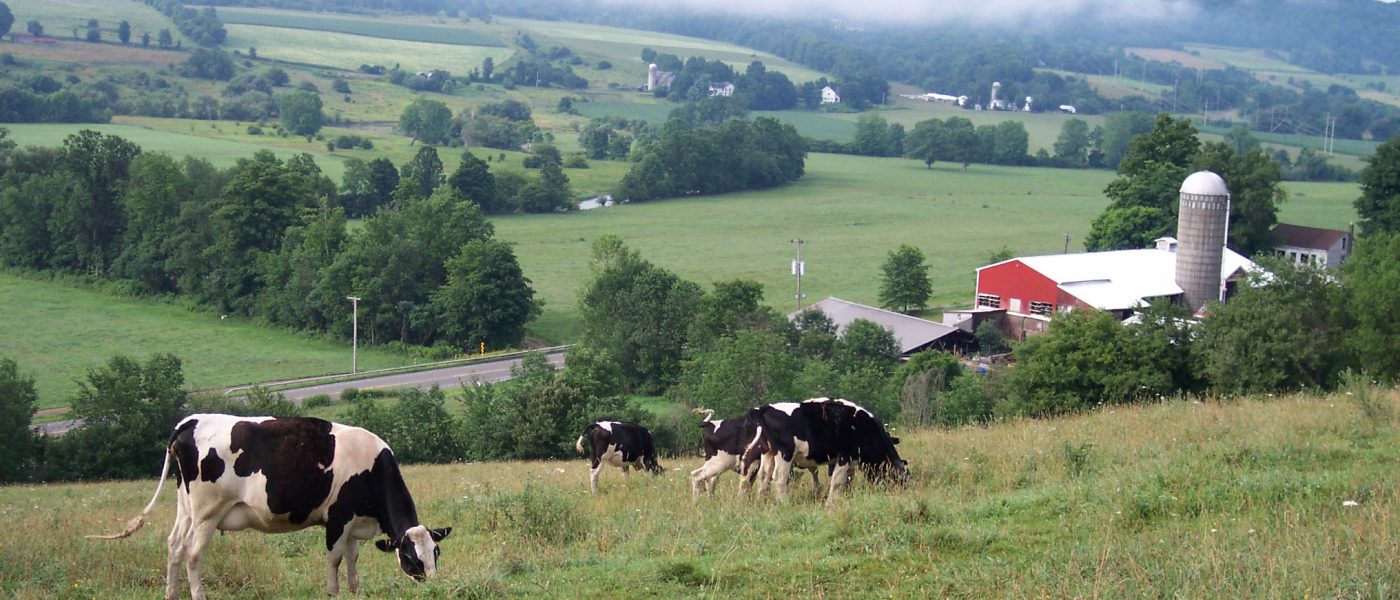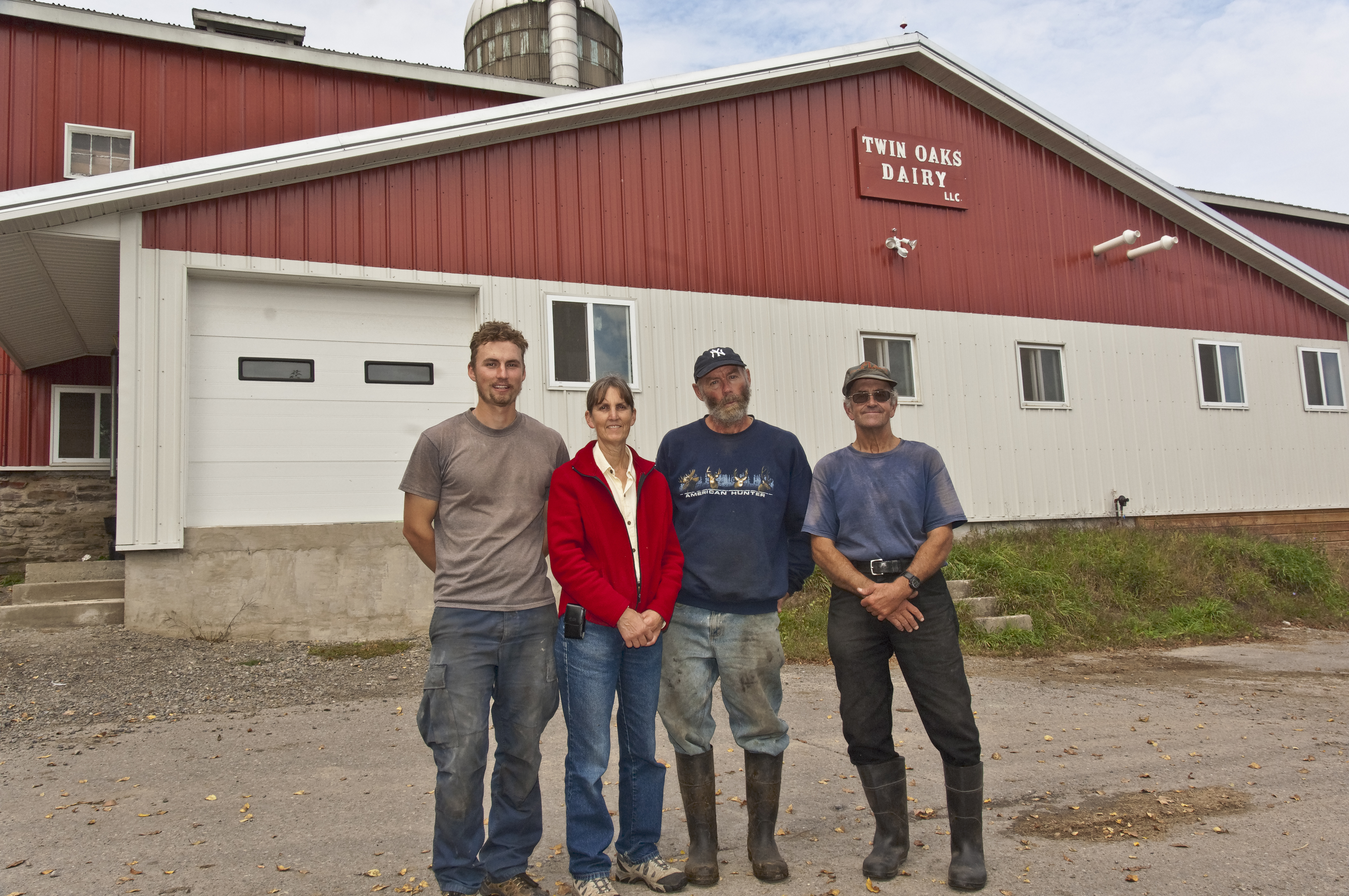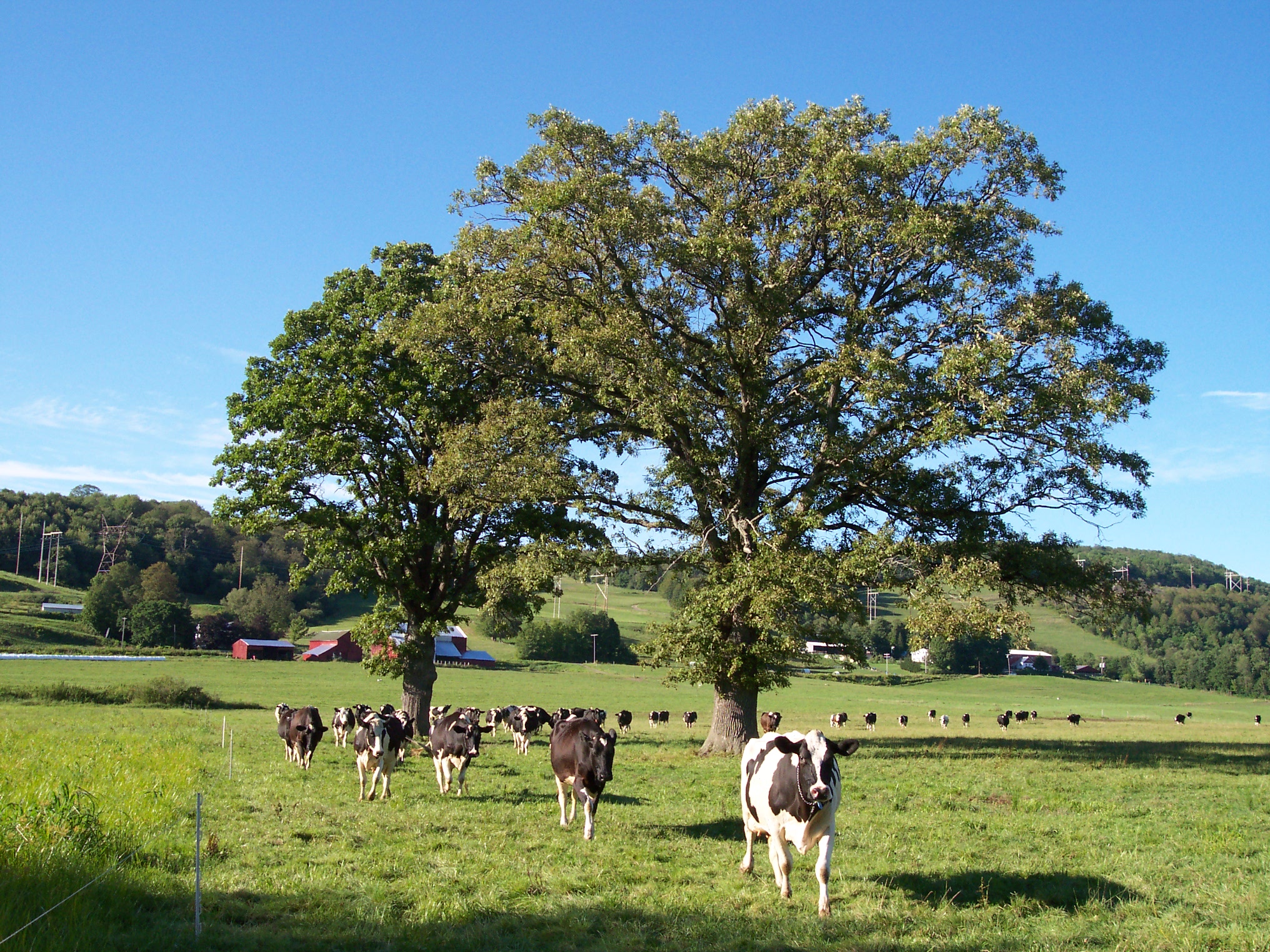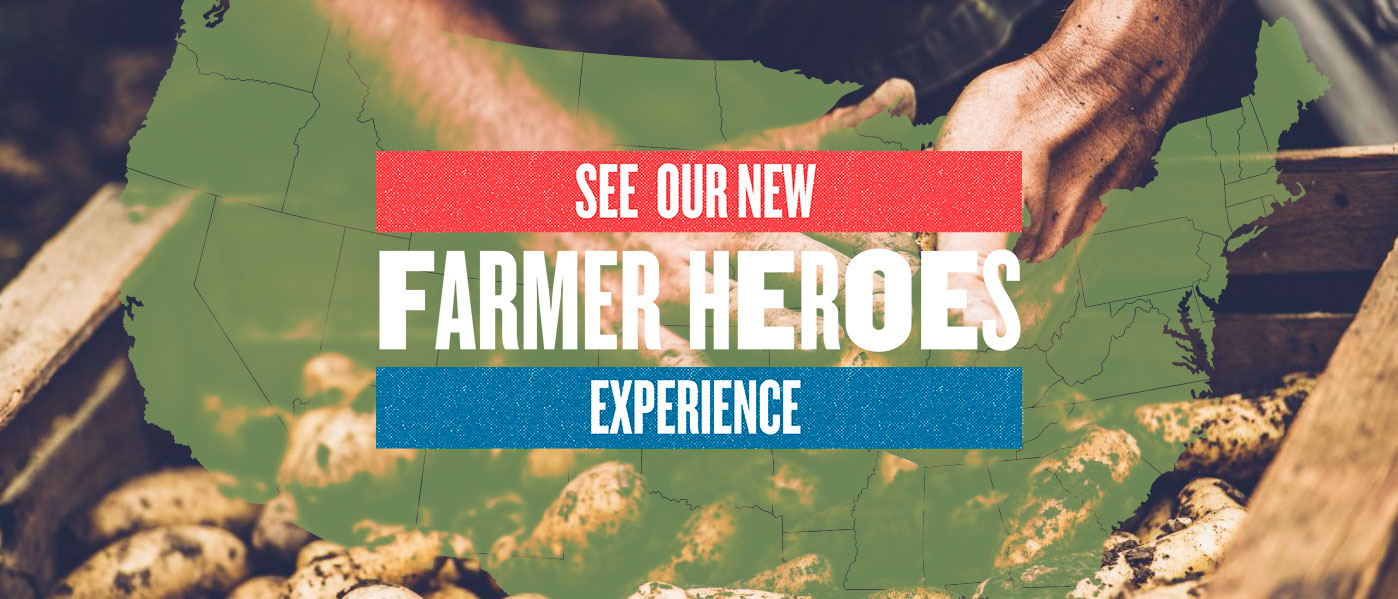The following story was written by Kathie Arnold for the March 2016 Northeast Organic Dairy Producers Alliance (NODPA) Newsletter. We were so moved by Kathie’s story that we got permission to reprint it here.
Picture a four year old girl and her 6 year old brother—back in the days before iPads, cell phones, video games, and even TV in most homes. Farm life activities were riding tricycles in the driveway, playing with our nearby cousins, going fishing in the river, building forts from the piles of fence posts, and wishing there were trees on our lawn so we could play in the leaves. Luckily, our grandparents lived on the other side of the road and they did have nice, big trees with lots of leaves. So my brother and I talked with our grandfather and he made us a deal—if we raked and bagged up the leaves, we could take them over to our lawn—and we only had to pay him 5 cents a bag of leaves for that privilege.
That was my first lesson in economics and business.
I grew up in the 50s and 60s, when the division of labor by gender was strong—my mother ran the household and my father the farm, as was the case with all farm families that I knew at the time. As I grew older, my responsibility was to help in the house and my brothers worked on the farm, although I was drafted by my father a few times during haying season to drive the John Deere tractor with the hand clutch to bale hay while he was on the wagon stacking bales, or to share in the work of unloading and mowing away hay.
Somewhere in my mid-teen years, I read Rachel Carson’s book Silent Spring. That book, which laid bare the deleterious effects of pesticides on the natural world, was a seminal part of my development and turned me into an environmentalist. I became a reader of Organic Gardening and Farming magazine and a practitioner as I gardened.
A shift was happening to see women, not just as “farm wives,” but as farmers themselves, as well as pursuing careers throughout the spectrum of agricultural services and business.
Also during my teenage years, news of the women’s liberation movement came into my world—a world where girls were not allowed to wear pants to my public school until I was in 11th grade. But at that time, I was rather stuck in the mindset of being a conformist and I didn’t shelve wearing dresses to school every day until my senior year. Since then, though, it is a rare day that I do wear a dress. I also dropped my habit of being a conformist and started thinking more for myself, rather than feeling I had to stay within the bounds of what the “authorities” believed or said.
Even though the gendered division of labor was practiced in my parent’s household and farm, I never heard a discouraging word from either of my parents about needing to only think about or pursue traditional female roles. They left that choice wide open to each of us—myself and four siblings. But at that time, I still didn’t consider being a farmer.
The fall of 1972, I went to Cornell University to major in Human Development and Family Studies at the College of Human Ecology. When it was time for me to think about what I was going to do for summer employment, the thought came to me that I had grown up on a farm but I didn’t know how to milk a cow, and it was time to change that fact. I told my father that I wanted to work on the farm that summer and that I would start the day at 5 AM, like he and my brother did. His reply was “OK, if that is what you want.”
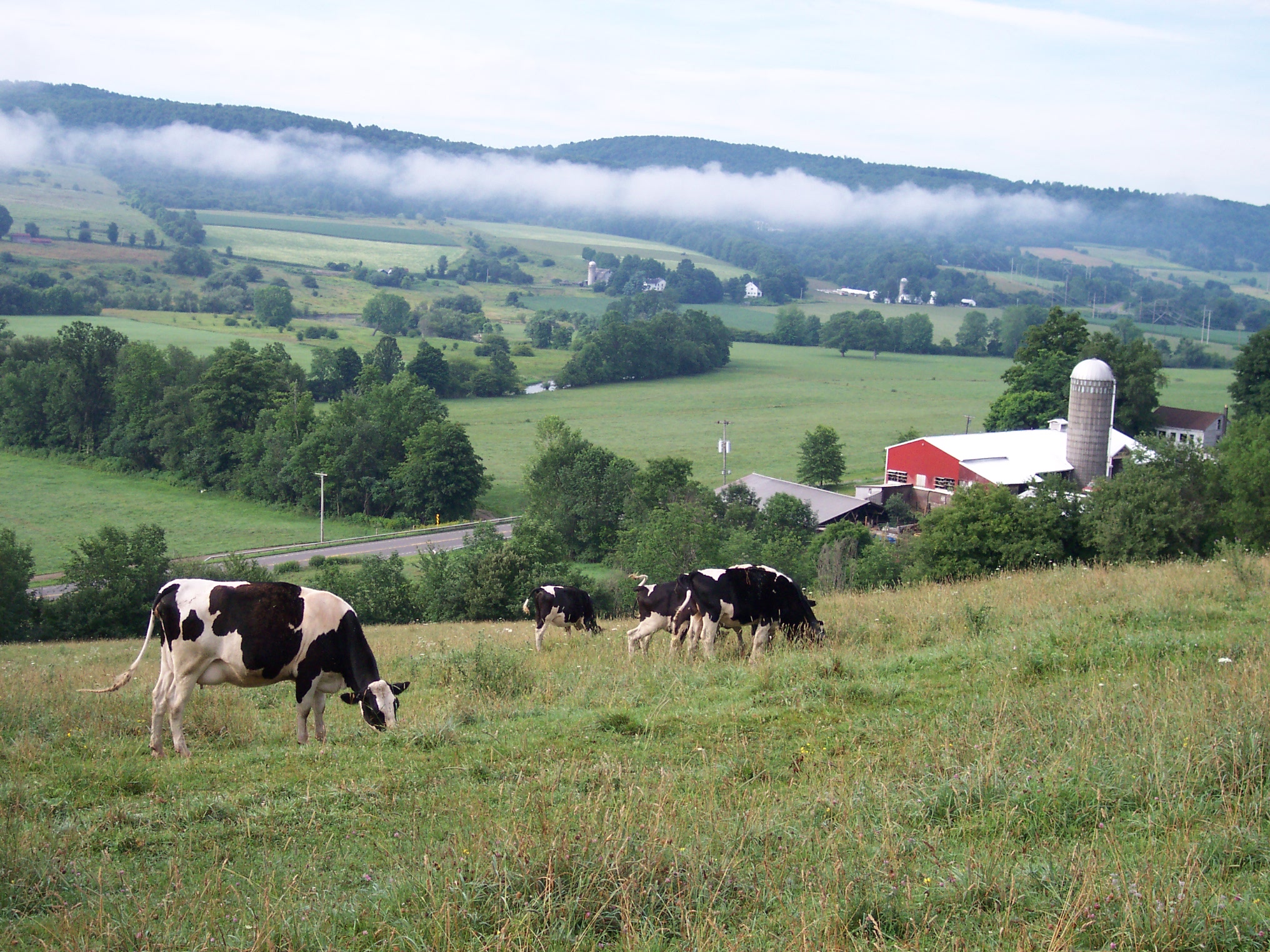
My older brother became my mentor that summer and taught me how to milk, how to drive tractors, run a haybine, and many other tasks. And I really enjoyed it.
I did the same the following summer, and the next summer I worked on two other farms to gain broader experience. I also started taking all my electives in the Ag School—including Farm Carpentry—where my brother and I built a hay wagon for our class project, as we were both taking the class at the same time. I approached the rather “old school” professor about hiring me as the teaching assistant in the course for the next semester—but he said no, no, we’ve got that covered already. I expect he was thinking that he couldn’t imagine a female student being the TA. But then, lo and behold, the beginning of the next semester, he called and asked if I would be willing to take the position after all. So I became the first female teaching assistant in the class known as “Boards and Nails” and then the next year, for the beginning welding class, “Arcs and Sparks” as well. This time I didn’t have to ask the professor—he prevailed upon me to please take the teaching assistant position.
While at Cornell, I did meet many other female age-mates who were in the ag school and who were interested in pursuing agriculture as a career. A shift was happening to see women, not just as “farm wives,” but as farmers themselves, as well as pursuing careers throughout the spectrum of agricultural services and business.
After college, I spent a school year in a volunteer/paid stipend position and then I was back to living and working at my parent’s farm. When my aunt by marriage, and my uncle, were up to visit one evening, she asked me if her brother were to ask me out, would I say yes. I knew a bit about Rick Arnold, as I had heard him sing and play guitar at a couple Truxton community events over the past few years, but I had been too reticent to introduce myself to him. With this ask, I didn’t hesitate to say yes, I would. So not quite 40 years ago, I formally met my husband to be. It took a couple years, and a break-up part way through, but we were married over 36 years ago.
At the time, Rick was working with his two brothers and mother on their family farm in Truxton. I was working part time at another farm in Truxton. Rick and I were not quite sure where we were going to head at the time we were married, but that became clear soon after when Rick’s oldest brother was diagnosed with melanoma and given a very low chance for survival. He not only farmed but also taught school full time. Faced with this health threat, he offered to sell his share of the farm real estate to Rick and me. Their mother, at age 65, decided she was willing to retire from the farm business. So on January 1, 1980, Rick, his 9 year older brother, Bob, and I went into partnership together and Twin Oaks Farm was born. Rick and Bob were very smart, strong, capable, and hardworking men; both had been working on the farm since early childhood because of their father’s ill health and subsequent death at age 57.
Prior to our partnership start date, a generic general farm partnership agreement from our Cooperative Extension Agent was revised into our formal partnership agreement. In any family farm situation it is important to have things legally written down as to ownership, how purchasing decisions over a certain dollar amount are to be made, how the agreement can be revised, a buy/sell arrangement spelled out, and so on. These need to be thoroughly thought through and agreed on. A parent telling an adult child that one day this will all be yours if you just stay and work here is not good enough. Maybe it will happen, but maybe it won’t either–and all the expectations someone may have had, after years of hard work and sacrifice, may very well go right out the window with the death of a parent, or their decent into dementia, or just with a change of mind. If it is not in a legally binding document, there are no assurances. It is often times not easy, but there is lots of help out there, from Cooperative Extension and Farm Net (in NY) to Farm Credit and other consultants.
In setting up our partnership, we did learn a lesson about choosing the right attorney. The lawyer we used lost the first partnership draft we gave him, then it was like pulling teeth to get things accomplished. It is important to choose an attorney who is well versed in one’s legal needs and who has a reputation for getting things done.
We also had our house lots deeded out of the partnership property so that we each owned our own homes. Doing that eliminated the potential for conflicts by allowing each family to make their own decisions regarding home improvements and investments, rather than having to make a joint business decision regarding spending money on the houses.
In the early years of Twin Oaks Farm, we kept many of the existing farm practices at first and continued to pasture the milking cows during the lush grass growth of May and June, then fed them greenchop out in a pasture for much of the rest of the growing season. We installed a pipeline and put new stalls in the barn, and over time, updated to better used equipment as cash flow would allow. We were all averse to borrowing money if it could be avoided, so we only bought what we could afford.
I learned about intensive grazing and we started breaking the pastures into somewhat smaller paddocks in the early years. But there was no organic market and our farm was in conventional production through the 80s and well into the 90s. I experimented with banding herbicide to reduce its usage. I experimented with cultivating corn and had some messes when timing and cultivation wasn’t good because of lack of knowledge and appropriate equipment.
As is the case today, the mainstream dairy farm push was for increased milk production. And we worked to that end. Our milk production rose during the 1980s so that by 1990 we had a 23,000 pound herd average. In 1991, we decided to keep our fresh cows and highest producing cows off pasture so we could feed them better and thus increase production. We did that for two years, and we did make more milk, but we also had many more cow health issues and a much bigger feed bill. So in 1993, we decided to go back to grazing the entire milking herd—this time with much more intensity, by giving them a new piece of pasture after every milking. We added crop acres into the pasture system so that we could graze for much more of the growing season.
That first intensive grazing season was stressful. We watched milk production decline as we attempted to learn the art of intensive grazing management, but we also saw our feed bill drop more than the production loss and we found cow health to be greatly improved. The following spring, we couldn’t wait to get the cows back out on pasture and we added even more cropland to the grazing system to have enough acreage to keep the cows on pasture into November. We were hooked on grazing as the way we wanted to farm.
A few years later, we had the opportunity to purchase 150 acres of contiguous, flat cropland just up the road from us. An opportunity like that often doesn’t come in a lifetime, so we readily embraced it and purchased the land. We looked into moving to organic production at that time, thinking that land could make us feed self-sufficient, but the organic market for milk in NY was only in its infancy in the mid 1990s. The sole buyer for organic milk only guaranteed paying a premium on 25% of milk production—the rest still at conventional price. So we passed on that, as the economics surely didn’t pencil out, and then we decided instead to start expanding our herd through internal herd growth.
The first winter, we out-wintered the cows that wouldn’t fit in the barn, and then the following year, we built a 32 stall freestall barn (later doubling the size)—still milking in our tie-stall barn and switching cows in and out between the two barns.
Around that time, Rick saw an ad in Country Folks newspaper looking for organic milk—$19/cwt or $5/cwt over blend price, whichever was higher, the ad read. That got our interest and led to the start of our transition. On May 1, 1998, we started shipping organic milk—a decision we have never regretted.
Three years later, in 2001, I traveled to Vermont to attend a summit meeting for organic dairy producers in the Northeast. This meeting was spurred by the fact that one of the processors was threatening to terminate contracts if producers didn’t submit to a lowering of their contracted pay price. NODPA was birthed at this summit and has had a very real and positive effect on the organic dairy milk market, as well as being an important vehicle to bring our farmer voice to the NOSB, NOP, and the greater regional and national stage. We farmers can have little impact on the bigger picture as individuals but when we come together into farmer driven organizations, that scale of voices with a cohesive message can accomplish much.
In 2001, after having attended a meeting on farm business structure, we decided to transform our business into a limited liability company. We worked with a Farm Credit consultant and a well versed attorney. We left all our farm real estate in the original partnership, Twin Oaks Farm, and then created a new entity, Twin Oaks Dairy LLC, to own the cows, the equipment, and the inventory. The benefit of putting an operating business into an LLC is that an operating entity is the business aspect where most of the potential liability resides. If a catastrophe strikes and we were to get sued, we could lose all the assets under the LLC, but any assets, like our homes being individually owned or the farm real estate owned by the partnership, could not be tapped in a lawsuit against the LLC.
It was also at this time that Rick and I planned and signed living wills, health care proxies, power of attorneys, and updated our wills. A living will specifies what kind of medical intervention you do or don’t want once certain guidelines you have set are met. It sounds like a lot of work but any good attorney will have templates available that you can easily adjust to suit your desires. In a health care proxy, you assign someone the authority to make medical decisions on your behalf should you become unable to make those decisions yourself. A power of attorney does the same thing for all things legal. And of course, a will establishes how you want your physical and financial assets to be disbursed. If you don’t have a will in place at the time of your death, your estate will need to be probated through the courts, which is a lengthy and public process, and may not allot your estate the way you would have wanted it to be distributed. These documents should be reviewed every several years, or when a change occurs that might require an update—for example if the person who is your health care proxy becomes chronically ill, or your children grow up and can fill some of these roles that they couldn’t when a minor. Having these documents in place not only is a safety measure for oneself, but they will be a big help to one’s family–that guidance and a legal framework for decision making has been prepared so that difficult and possibly heart rending decisions do not have to be made in a vacuum, nor cause a crisis if something happens to cause incapacitation or death and there is no power of attorney or will. Financial assets can become frozen and can lead to business failure.
By the fall of 2003, Rick began noticing loss of dexterity with his right hand and slowed movement in his right arm. We started visiting doctors to try to track down the cause. By January of 2004, he received the diagnosis of Parkinson’s Disease. That began our long journey between conventional neurologists and alternative practitioners, in order to do anything we could to slow the progression.
In the fall of 2005, we took a trip to Switzerland, Rick’s father’s homeland, while Rick was still able to make such a trip. We had a wonderful time in a country of magnificent beauty. Another piece of advice, do not wait too long to do things that are important to you, because they may become impossible with the passage of time.
In 2009, a 27.6 kW photovoltaic system, mounted on poles with 2-way tracking was finally installed on our farm after having been in the works for the prior few years. The system became operational in 2010. Although it has not reduced our purchased electrical usage to zero, as the system was sized to do, it has reduced it by around 2/3rds. Since the time we signed the contract, the price of PV panels has dropped dramatically, making installation of PV systems more viable but making costly tracking systems outmoded.
By this time, our son Kirk had become an instrumental part of the farm labor scene and took on growing farm responsibilities as Rick’s decreased. Although Rick had been able to continue working during the first few years of his Parkinson’s diagnosis, with time came increasing disability and the need to revise what jobs he did. Then, as time went on, we had to restrict and supervise what he did.
About the same time, his brother, our farming partner, had growing issues with his hands and shoulders and started exhibiting poor judgment around the farm. It was a difficult time. Imagine how to deal with situations where someone can no longer competently do what they have done for decades and yet they are an owner of the business and are not really aware of their loss of proficiency. I have to credit our son, Kirk, with coping with and managing this challenge, to a greater extent than I did, given what areas of farm work we each were most involved in. For sure, it was a real trial on many levels, for a barely 20 year old to deal with his father and uncle under these circumstances—especially when the dream had been for father and son to farm together.
This confluence prompted a gathering of advisors from Farm Credit, Farm Net, our attorney, accountant, and close family members. With their guidance, we went through farm transfer work and both of my 30 year partners exited the business as owners, and Kirk became an owner/operator. Although moving into that role at age 22 may not have been ideal, it fit the circumstances and need and Kirk became my very able and responsible business partner.
Because we had buy/sell procedures and methods already set out in our partnership agreement and the LLC agreement for such transitions to happen, there was no crisis, there was just the working out of details and carrying things through. My brother-in-law continued to work for us on the farm, in select jobs, for as long as his body was able, as he wished.
Shortly after, I took Rick to the University Hospital in Rochester for him to be evaluated for deep brain stimulation surgery, where fine wires connected to an electrical stimulator are implanted in the brain, to help with Parkinson’s symptoms. The final evaluation by the neuro team there was that Rick had something more than Parkinson’s—they didn’t know what—but called it Parkinson’s Plus, and told us they were sorry, but there was nothing they could do to help.
More disability continued to accrue for both Rick and Bob. In 2012, Bob was tentatively diagnosed with ALS. Then genetic testing showed he had a genetic mutation for frontotemporal degeneration, FTD in shorthand, which can be partnered with ALS. Bob’s genetic testing results, and the knowledge that their father had died young after several years of dementia, prompted genetic testing of Rick. He also was positive for the same genetic mutation for frontotemporal degeneration.
These last few years were when the other legal documents that I mentioned previously came in to play for us. As Rick’s cognition diminished, I needed to exercise the power of attorney to take care of Rick’s finances and other legal matters. I needed to exercise the health care proxy to make medical decisions. And both Bob and Rick’s living wills came into play, when they each declined last year, to the point of being unable to swallow. Given their conditions, their living wills spelled out no feeding tubes and no IVs. So there were no trips to the hospital at life’s end, there were no heroic interventions, but there were calls to Hospice to provide palliative care. They each stayed in their own homes, in their known environment, cared for by their families, and with their family members at their sides at the time of each passing.
Our families, our lives, and the farm have evolved, much to our sorrow and loss of how we had dreamed it would go. But we who are still here and living have to continue on, even with that empty space in our hearts. Rick and Bob’s parents started this farm in the 1930s and Kirk and I are continuing this now third generation farm, looking to the future and how to evolve into a more efficient farm, with continuing viability.
We can’t really prepare for the heartache and loss that life brings us. We have to work through it on a personal level and adapt as time goes on. We have to accept that change is going to happen. But through planning and preparation, we can avoid crises and unnecessary turmoil and conflict. Are you prepared for the unforeseen, the unwanted, the unwelcome bends of life? If on a multi-family member farm, is your position secure through a written agreement? Is your will, power of attorney, healthcare proxy, and living will in place and up to date? The bends of life will come—sooner or later. Be prepared in the ways that you can.
